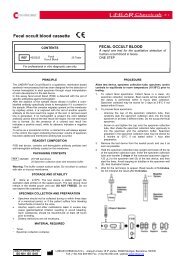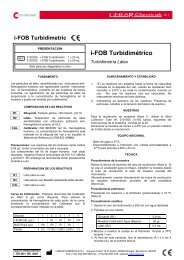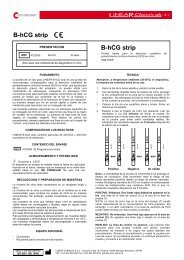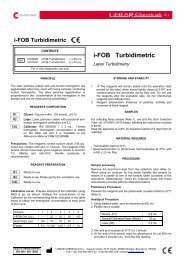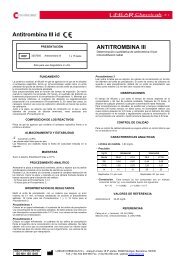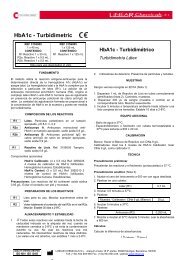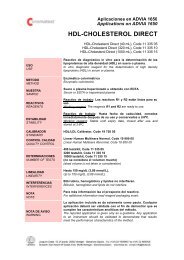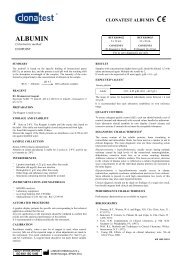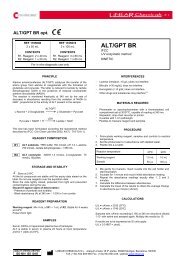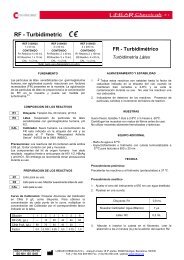GGT BR - Linear
GGT BR - Linear
GGT BR - Linear
You also want an ePaper? Increase the reach of your titles
YUMPU automatically turns print PDFs into web optimized ePapers that Google loves.
CLONATEST <strong>GGT</strong> <strong>BR</strong><strong>GGT</strong> <strong>BR</strong>IFCCEnzymatic colorimetric methodKINETICREF CT10192REF CT101953 x 50 mL 12 x 50 mLCONTENTSCONTENTSR1.Reagent 3 x 40 mL R1.Reagent 12 x 40 mLR2.Reagent 3 x 10 mL R2.Reagent 12 x 10 mLFor in vitro diagnostic use onlySUMMARYGamma-glutamyltransferase (γ-GT) catalyzes the transfer of a γ-glutamylgroup from γ-glutamyl-3-carboxy-4-nitroanilide to glycylglycine with theformation of L-γ-glutamyl-glycylglycine and 5 amino-2-nitro-benzoate.The amount of 5-amino-2-nitro-benzoate formed, monitored kinetically at405 nm, is proportional to the enzyme activity present in the sample. 1(L-γ-Glutamyl) -3-carboxy-4-nitroanilide(L-γ-Glutamyl) -glycylglycine + 5-amino-2- nitro-benzoateREAGENTSR1. Buffer. TRIS 133 mmol/L, glycylglycine 138 mmol/L.R2. Substrate.. L-γ-Glutamyl-3-carboxy-4-nitroanilide 23 mmol/L.PREPARATIONThe Reagents are ready-to-use.STORAGE AND STABILITYStore at 2-8ºC. The Reagents are stable until the expiry date stated onthe label. After daily use stored tightly closed and protected from light.On board the reagents are stables 30 days.Discard the reagent if the blank presents an absorbance over 1.200 at 405nm against distilled water.SAMPLE COLLECTIONSerum or EDTA plasma free of hemolysis. Fluoride, citrate and oxalateinhibit γ-GT activity 2 .The enzyme in the sample is stable for at least 1 week at 2-8ºC and for atleast 2 months when frozen.INTERFERENCES 6−−−−Lipemia (intralipid >2.5 g/L) may affect the results.Bilirubin (> 10 mg/dL) may affect the results.Hemoglobin (> 8 g/L) may affect the results.Other drugs and substances may interfere 6 .INSTRUMENTATION AND MATERIALS−−−−LIDA analyzer.Laboratory equipment.iso-Clean Solution. Ref. CT18002.Multicalibrator CC/H 10x3 mL Ref. CT19750AUTOMATED PROCEDUREA graphic display pictures the specific sets corresponding to the technicalapplication outlined for this test.Any new application, to the instrument should be validated to confirm thatresults meet the analytical performance of the method.It is recommended to validate periodically the instrument.CALI<strong>BR</strong>ATIONγ-GTGLYCYLGLYCINENo calibration is required. Activity is calculated against theoretical factor.CALCULATIONPatient values are calculated automatically by theoretical factor.RESULTSSamples with ΔA/min exceeding 0.200 at 405 nm should be diluted 1:10with saline and assayed again. Multiply the results by 10.If results are to be expressed as SI units apply: U/L x 16.67 = nkat/LEXPECTED VALUES 4Serum, plasmaTemperature 37ºC 30ºC 25ºCMenWomen10-50 U/L(167-834 nKat/L)8-35 U/L(133-583 nKat/L)7-35 U/L(117-538 nKat/L)6-25 U/L(100-417 nKat/L)5-25 U/L(83-417 nKat/L)6-25 U/L(83-300 nKat/L)It is recommended that each laboratory establishes its own referencerange.QUALITY CONTROLTo ensure adequate quality control (QC), each run should include a set ofcontrols (normal and abnormal) with assayed values handled as unknowns.Each laboratory should establish its own Quality Control scheme andcorrective actions if controls do not meet the acceptable tolerances.DIAGNOSTIC CHARACTERISTICSGamma-glutamyl transferase is the most sensitive enzymatic indicator ofhepatobiliary disease available. It is highest in cases of intrahepatic orposthepatic biliary obstruction, and is more sensitive than alkalinephosphatase in detecting obstructive jaundice, colangitis, andcholecystitis.Elevated levels are noted in the sera of patients with alcoholic cirrhosisand from people who are heavy drinkers. The enzyme levels are importantin detecting alcohol induced liver disease correlating well with theduration of the drug action.Clinical diagnosis should not be made on findings of a single test result,but should integrate both clinical and laboratory data.PERFORMANCE CHARACTERISTICSPerformance characteristics are available on request.BIBLIOGRAPHY1.2.3.4.5.6.IFCC methods for the measurement of catalytic concentration ofenzymes. Part 4. IFCC method for γ-glutamyltransferase. J. Clin.Chem. Clin. Biochem. 21: 643-646 (1983).Whitfield, J. B., Moss, D.W., Neale, G., Orme, M., y Breckenridge,A. Brit. Med. J. 1 : 136 (1973).Szasz, G. Clin. Chem. 15 : 124 (1969).Tietz. N.W. Fundamentals of Clinical Chemistry, p.940. W.B.saunders Co. Philadelphia, PA. (1987).Friedman y Young. Effects of disease on clinical labotatory tests. 5 thed. AACC (Press 2000).Young DS. Effects of drugs on clinical laboratory tests, 5th ed.AACC Press, 2000.CT1019-2/0811R1.ingQUALITY SYSTEM CERTIFIEDISO 9001 ISO 13485LINEAR CHEMICALS S.L.08390 Montgat, SPAIN (EU)
CLONATEST <strong>GGT</strong> <strong>BR</strong><strong>GGT</strong> <strong>BR</strong>IFCCMétodo enzimático colorimétricoCINETICOREF CT10192REF CT101953 x 50 mL 12 x 50 mLCONTENIDOCONTENIDOR1.Reactivo 3 x 40 mL R1.Reactivo 12 x 40 mLR2.Reactivo 3 x 10 mL R2.Reactivo 12 x 10 mLSólo para uso diagnóstico in vitroFUNDAMENTOLa gamma-glutamiltransferasa (γ-GT) cataliza la transferencia del grupoγ-glutamilo de la γ-glutamil-3-carboxi-4-nitroanilida a la glicilglicina conla formación de L-γ-glutamil-glicilglicina y 5-amino-2-nitrobenzoato.La cantidad de 5-amino-2-nitrobenzoato formado, controladacinéticamente a 405 nm, es proporcional a la actividad de γ-GT presenteen la muestra. 1γ-GT(L-γ-Glutamil) -3-carboxi-4-nitroanilidaGLICILGLICINA(L-γ-Glutamil) -glicilglicina + 5-amino-2- nitrobenzoatoREACTIVOSR1. Tampón. TRIS 133 mmol/L pH 8,2, glicilglicina 138 mmol/L.R2. Sustrato. L-γ-glutamil-3-carboxi-4-nitroanilida 23 mmol/L.PREPARACIONLos Reactivos están listos para su uso.ALMACENAMIENTO Y ESTABILIDADConservar a 2-8ºC. Los Reactivos son estables hasta la fecha decaducidad indicada en la etiqueta.Después de su uso diario, mantenerlos bien cerrado y protegidos de la luz.En el analizador son estables 30 días.Desechar el reactivo si el blanco presenta una absorbancia superior a1,200 a 405 nm frente agua destilada.MUESTRASSuero o plasma obtenido con EDTA, libre de hemólisis. El fluoruro,citrato y oxalato inhiben la actividad enzimática 2 .La γ-GT es estable en suero o plasma 1 semana a 2-8ºC y por lo menos 2meses a –20ºC.INTERFERENCIAS−−−−Lipemia (intralipid >2,5 g/L) puede afectar los resultados.Bilirrubina (> 10 mg/dL) puede afectar los resultados.Hemoglobina (> 8 g/L) puede afectar los resultados.Otros medicamentos y sustancias pueden interferir 6 .EQUIPO ADICIONAL−−−−Analizador LIDA.Material de laboratorio.iso-Clean Solution. Ref. CT18002.Multicalibrator CC/H 10x3 mL Ref. CT19750TECNICA AUTOMATICAUna representación grafica visualiza los ajustes específicoscorrespondientes a la aplicación técnica diseñada para este ensayo.Cualquier aplicación nueva al instrumento deberá validarse paraconfirmar que los resultados cumplen las características del método.Se recomienda validar periódicamente el instrumento.La actividad se calcula aplicando un factor teórico.CALI<strong>BR</strong>ACIONNo precisa calibración.CALCULOSEl valor de las muestras se calcula automáticamente con el factor teórico.RESULTADOSMuestras con ΔA/min superiores a 0,200 a 405 nm deben diluirse 1:10con solución salina y repetir el ensayo. Multiplicar los resultados por 10.Para expresar los resultados en unidades SI aplicar: U/L x 16,67 = nkat/LVALORES DE REFERENCIA 3Suero, plasmaTemperatura 37ºC 30ºC 25ºCHombresMujeres10-50 U/L(167-834 nKat/L)8-35 U/L(133-583 nKat/L)7-35 U/L(117-538 nKat/L)6-25 U/L(100-417 nKat/L)5-25 U/L(83-417 nKat/L)6-25 U/L(83-300 nKat/L)Se recomienda que cada laboratorio establezca su propio rango de referencia.CONTROL DE CALIDADPara un control de calidad (CC) adecuado, se incluirán en cada seriecontroles valorados (normal y abnormal) que se tratarán como muestrasproblema.Cada laboratorio debe establecer su propio Control de Calidad y susmedidas correctoras cuando los controles no cumplan con las toleranciasexigidas.SIGNIFICADO CLINICOLa gamma-glutamil transferasa es el indicador enzimático disponible mássensible de la enfermedad hepatobiliar. Los aumentos más altos se hallanen los casos de obstrucción intra o posthepática, siendo más sensible quela fosfatasa alcalina en la detección de la ictericia obstructiva, colangitis ycolecistitis.Se hallan asimismo aumentos elevados en sueros de pacientes con cirrosisalcohólica y en el grupo de bebedores contumaces. Los nivelesenzimáticos son importantes en la detección de la enfermedad hepáticainducida por el alcohol, correlacionándose bien con la duración de laacción de la droga.El diagnóstico clínico no debe realizarse únicamente con los resultados deun único ensayo, sino que debe considerarse al mismo tiempo los datosclínicos del paciente.CARACTERISTICAS ANALITICASLas características analíticas están disponibles bajo solicitud.REFERENCIAS1.2.3.4.5.6.IFCC methods for the measurement of catalytic concentration ofenzymes. Part 4. IFCC method for γ-glutamyltransferase. J. Clin.Chem. Clin. Biochem. 21: 643-646 (1983).Whitfield, J. B., Moss, D.W., Neale, G., Orme, M., y Breckenridge,A. Brit. Med. J. 1 : 136 (1973).Szasz, G. Clin. Chem. 15 : 124 (1969).Tietz. N.W. Fundamentals of Clinical Chemistry, p.940. W.B.saunders Co. Philadelphia, PA. (1987).Friedman y Young. Effects of disease on clinical labotatory tests. 5 thed. AACC (Press 2000).Young DS. Effects of drugs on clinical laboratory tests, 5th ed.AACC Press, 2000.QUALITY SYSTEM CERTIFIEDISO 9001 ISO 13485LINEAR CHEMICALS S.L.08390 Montgat, SPAIN (EU)



